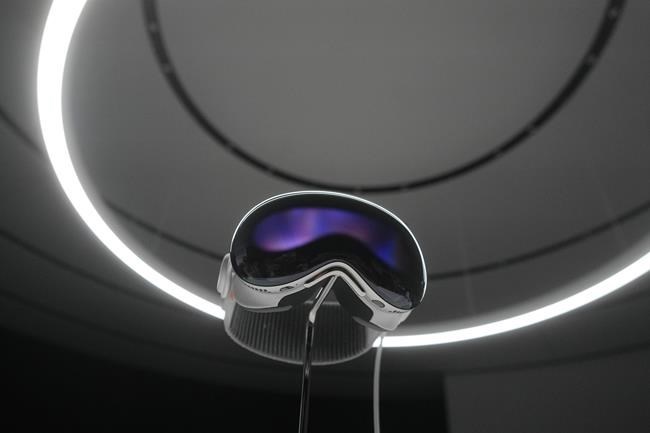TORONTO — Canadian tech companies say Apple's new Vision Pro headset gives them hope that augmented and virtual reality wearables could catch on with consumers and businesses.
The headset unveiled Monday creates an augmented reality experience where wearers can connect with one another, conduct meetings, watch movies or even play games. The augmented reality component means users can naturally see their surroundings and browse pages or apps by looking in different directions or gesturing with their hands.
Vision Pro will be available next year and retail for US$3,499, but the price isn't the only thing that could make it a hard sell. Precursors like Meta’s Oculus headsets or Google Glass have yet to reach widespread adoption because of their high cost and lack of existing use cases.
VR and AR companies believe Vision Pro may shift perceptions of such wearables.
“We think it is a rising tide that will raise all the ships in the industry,” said Raja Khanna, chief executive of Lumeto, a Toronto company using virtual reality to train health care practitioners to complete complex procedures like intubations.
He thinks the Vision Pro is a "beautiful headset" that resolves a lot of the problems past wearables had because users will see their real surroundings and use hand gestures, making the experience feel less isolating.
Its EyeSight capabilities mean that when a person approaches someone wearing Vision Pro, the device feels transparent, allowing the people to see one another. When a user is immersed in the device, EyeSight gives visual cues to others about what the user is focused on.
Even with such flashy features, Khanna thinks the US$3,499 price tag will be prohibitive for many customers, but he feels Apple is likely already planning a lower cost version.
"This is still an industry that is in its early days for early adopters on the consumer side," he said. "I think Apple understands that and they're not pretending like they can jump or leapfrog to a mass consumer audience just yet."
Like Khanna, XpertVR co-founder Evan Sitler-Bates thinks cost will keep some people from grabbing the device right away, but believes Apple will follow its past habits and bring the price down with successive releases, eventually making it more accessible to consumers.
"I'm excited and looking at this as iPhone No. 1 and over the next three to five years, we're going to see continuous iterations of this," he predicted.
His Niagara Falls, Ont.-based company develops VR software to train firefighters, medical and human resources professionals, but he believes Vision Pro could spur even more businesses to experiment with such technology because Apple excels at focusing on designing products in an intuitive and easy-to-use way.
"Nowadays you put on a VR headset and it can take half-an-hour to an hour to really get everything set up and to get acclimated to the VR space, whereas Apple is really good at having amazing user experiences," he said.
"It's going to really push the industry forward and (show) just how easy it is to get people into the software."
Vision Pro comes at a time where people are considering the future of many immersive technologies, pointed out Jeff LaFrenz, who runs VizworX, a Calgary company creating immersive software for sectors including agriculture, health care, defence and aerospace.
VR creates wholly artificial environments, while AR overlays sensory information like sounds or visuals on top of a user's actual environment. "Extended reality" is an umbrella term encompassing both VR and AR that is used to denote immersive digital worlds.
“These terminologies that are thrown around these days have been progressing quite well and steadily within the industrial, commercial domain,” LaFrenz said.
“But in the consumer domain, of course, it hit a major snag with the rise and fall of Meta.”
Meta, the parent company of Facebook, Instagram and WhatsApp, built a virtual but interactive realm known as the metaverse, where founder Mark Zuckerberg envisions people working and playing for generations to come.
A report released in May by consulting firm Deloitte, which the tech giant commissioned last year, estimated the metaverse could contribute between $45.3 billion and $85.5 billion to Canada’s annual GDP by 2035, making up 1.3 per cent to 2.4 per cent of the country's GDP.
Yet the Quest headsets used to access the metaverse aren't a fixture in most homes or businesses. They haven’t caught on because creating metaverse worlds is “uninteresting and gimmicky,” whereas Vision Pro is “very human centric” and offers “no shortage of ways” to use it, Neil Saunders, managing director of GlobalData, wrote in an investor note.
However, the Quest and metaverse push “raised questions around if there a future for augmented reality, virtual reality and so on ... or was this an interesting tech that had a day and then disappeared?” LaFrenz said.
“The announcement from Apple breathed life into that (technology) and showed that at least from the larger technology company perspective, this is certainly not an end point but a recognition that it hadn't found the sweet spot.”
This report by The Canadian Press was first published June 6, 2023.
Tara Deschamps, The Canadian Press




